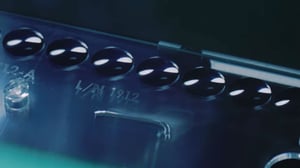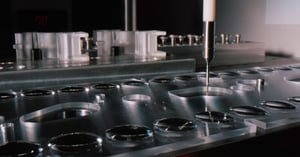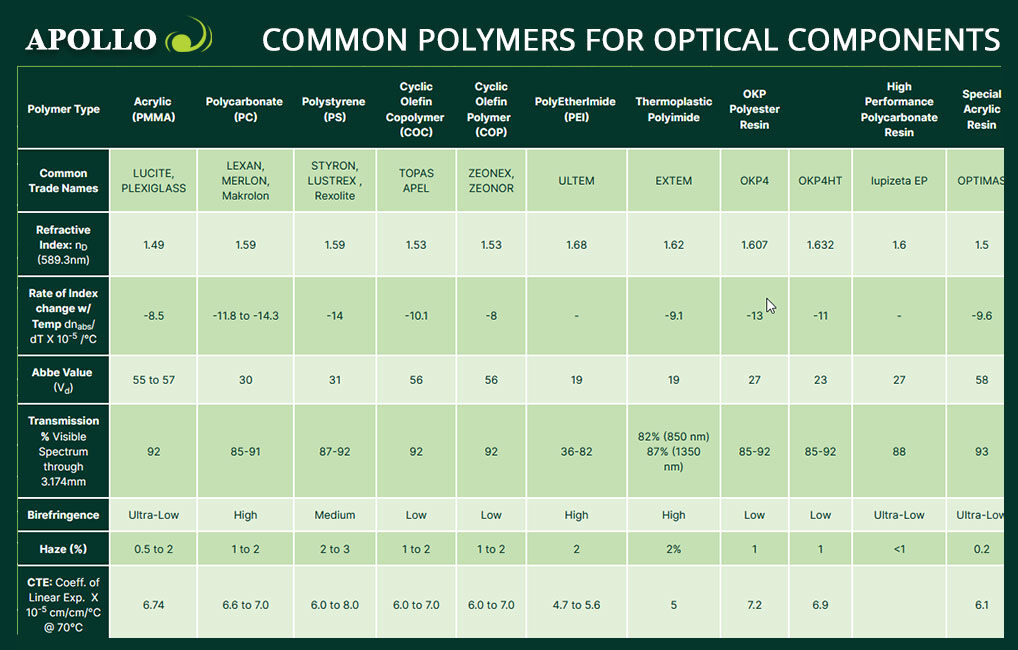
Polymer Injection Molding
Apollo Optical Systems specializes in precision polymer injection molding to produce high-quality optical components for many industries, including automotive, medical devices, tactical applications, consumer electronics, lighting, and defense.
Precision Polymer Molding: Apollo’s Commitment to Excellence
Apollo’s molding technology produces consistent, high quality parts exceeding or meeting all current industry standards. Our focus is on partnering with our customers to provide them with the required information through our experience and capabilities that will enable them to achieve their polymer-based optical product expectations. The key element to this process is the ownership that everyone at Apollo takes in every program that we are involved in. Our goal is to ensure that mutual success is a deterministic process.
Injection Molding & The Apollo Method
Our comprehensive approach to manufacturing polymer optics results in significant advantages for our customers. We internally provide all the critical capabilities required to ensure program success. These capabilities include:
- Optical component and system design
- Mechanical design
- Mold design
- Single point diamond turning of prototype polymer lenses and optical
inserts - Fixture design and fabrication
- Packaging design
- Low and high-volume assembly experience
- Unique bonding processes for fabrication of polymer doublets and triplets.
- Materials expertise
- Scientifically approached mold processing
- Extensive metrology capable of measuring any component we manufacture
- Assigned Program Manager on every product we manufacture
We have the expertise and experience to develop the right solution for your optical requirements.
We combine our own internal capabilities with strategic technology partners to provide a full range of optical forms and services:
- Spherical, aspheric and Fresnel surfaces
- Diffractive surfaces
- Custom optical diffusers
- Microlens arrays
- Anti-reflective and reflective evaporative coatings
- Protective dip coatings
Versatility of Injection Molding in Polymer Part Manufacturing
Polymer injection molding is a manufacturing process where polymer granules are melted and injected under high pressure into a mold to create precise optical components. This method is ideal for mass-producing identical parts with complex geometries, such as spherical, aspheric, and diffractive surfaces. It offers advantages like low per-unit costs, high repeatability, and excellent design flexibility.
Nearly every plastic part you encounter was manufactured with injection molding, including some electronics components, kitchen appliances, and car parts. This manufacturing method is popular because of its low cost for high-volume production, high repeatability, and excellent design flexibility.
How Injection Molding Works
Injection molding is a popular manufacturing method for polymer parts. It has a wide range of uses, including consumer electronics, packaging, toys, and miniature, complex industrial uses like medical technology and automotive manufacturing.
Here are some common examples of injection-molded products:
- LEGO bricks
- Bottle caps
- Model airplanes
- Car parts like bumpers, dashboards, and interior pieces
- Consumer electronics
- Sterilizable and biocompatible materials for medical devices
- Diagnostic test kits
- Surgical prep products
- Window roller assembly
- Conveyor system components
- Food and beverage containers
- Beverage filtering components
The Manufacturing, Design Guide & Use
An injection molding machine consists of three parts:
- The injection unit
- The mold
- The clamping/ejector unit
The injection unit is used to melt the raw polymer and guide it into the mold, consisting of the hopper, barrel, and reciprocating screw.
The injection molding process is as follows:[2]
The polymer granules are dried and placed in a hopper, where they are mixed with reinforcing additives or pigments.
The polymer granules are fed into the barrel, where they are heated, mixed, and shifted toward the mold by the screw. Both the screw and barrel are optimized to create pressure buildup and melt the polymer material.
The ram moves forward, and the melted polymer is injected into the mold with the runner system. As it cools, it solidifies and takes on the shape of the surrounding mold.
When the process is finished, the mold opens, and the ejector pins eject the solid piece.
The process is repeated for each unit.
As a whole, the injection molding process takes around 30 to 90 seconds to complete a full cycle for each individual unit. Injection-molded parts are typically ready to use immediately and require no post-processing.
The mold for injection molding is similar to a photo negative. The surface texture and geometry are reversed and transferred onto the injection-molded unit. A high level of expertise is required to design and manufacture a high-quality mold that can accurately produce hundreds of thousands of components.
Molds are typically machined out of aluminum or steel with a CNC. They may have additional features beyond the negative of the part, such as the runner system or internal water cooling components.
Sources:
[1] https://spie.org/samples/FG37.pdf
[2] https://wp.optics.arizona.edu/optomech/wp-content/uploads/sites/53/2016/10/Plastic-Optics.pdf
LATEST NEWS & EVENTS



